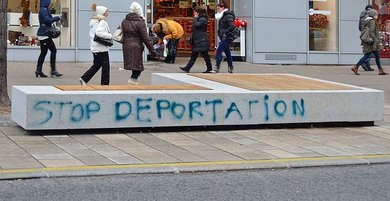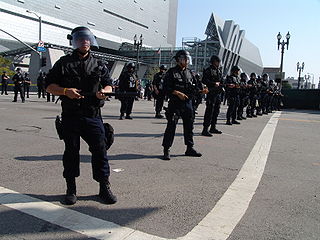[CONTENT/TOPIC WARNING: Descriptions of violence, conflict, confinement. Strong moral exhortations and confrontational questions. Please be prepared when reading.]
I have said before, and I will keep saying: forcing people to return to violence they have escaped is an open endorsement of that violence, a collusion with their persecutor back home and a joining of the open threat on their lives.
Every year the U.S. mass-exile system forces thousands of people to return to war zones and other dangerous places where they may be and sometimes are murdered with impunity.1 Some of those deported are children. Nowhere is this more true than in Central American states like Honduras, El Salvador and Guatemala, where a toxic brew of corruption, organized crime and neo-colonial fallout have generated ubiquitous violence and the highest murder rates in the world.2 Immigration and Customs Enforcement (ICE) returns many immigrants from Central America to these same states where they are being hunted. You could say they are delivered into the hands of their killers – that their murder is enabled, even assisted, by their deportation, by their deporters.
One study found that between January 2014 and September 2015 eighty-three deportees who were sent back to Honduras, Guatemala, and El Salvador were murdered after their return.3 They were people fleeing the killers who eventually took their lives. People like José Marvin Martínez, who fled violence in Honduras and made it to the U.S. when he was 16, but was deported and four months after his forcible return was shot to death.4 Or Juan Francisco Diaz, also deported back to Honduras, where he too was murdered a few months later.5 Or Giovanni Miranda, who, after spending most of his life in the U.S., was deported to El Salvador to be murdered in front of his wife and son in June 2015.6 Or Edgar Chocoy, 16, who ran away from a gang to the U.S. only to be murdered by that same gang seventeen days after he was deported back to Guatemala in 2004.7 Or an unnamed teenager who was shot to death hours after being deported back to San Pedro Sula, Honduras.8 Moises, 19, was murdered after he was deported to El Salvador.9 And there are too many more names we’ll never know.
What’s more, the number of deportees delivered directly to their killers does not include those who survive attempted murder or other violence because of their deportation – a number no one knows. Isais Sosa, who was 19 when the Los Angeles Times covered his story in 2014, survived being shot by a gang days after his deportation.10 The 19 year old daughter of Dora Lina Meza fled to the U.S. from the same gang that, after she was deported back home, raped her at gun point.11 After Juan Ines Alanis was deported he was kidnapped and held for ransom while his fingers were smashed with a hammer.12
The use of euphemism is a common tactic for masking brutality. Many have discussed the use of “bureaucratic euphemisms” to direct attention away from acts of violence in the context of slavery,13 genocide14 and torture,15 for example. From “special resettlement” to describe the forced relocation and mass murder of millions under Stalin,16 to “sleep adjustment,” and “enhanced interrogation techniques” to describe torture in the Abu Graib prison.17 “Euphemism” comes from the Greek word euphemismos, meaning to use favorable words in place of inauspicious ones,18 literally “eu” and “pheme” together mean “good talk.”19 The only reason to use favorable words to describe human suffering is to hide that suffering from yourself and others. But human beings deserve to have their “inauspicious” suffering described as accurately and directly as possible.
The process of deporting people to their death or maiming is facilitated and hidden from us through the use of euphemism. When we strip away the “auspicious” language, we’re forced to confront honestly the suffering of exiled people and our role in their fate. ICE “detains” (kidnaps20) human beings for the purpose of “deporting” (condemning) them to their “home countries” (war zones) where ICE knows that they could be “persecuted” (raped or murdered in cold blood). But while the euphemism is used to hide culpability, the fact of culpability remains. Where A knows that C will murder B if C finds B; and A kidnaps B and delivers B to C – isn’t A guilty of something? When we acknowledge that ICE knowingly facilitates the death of human beings, it makes it difficult not to assign that institution some amount of moral responsibility and culpability for their actions. The evil of euphemisms used to describe evil should be obvious: talk about violence should be direct and honest because we collude with that which we hide and keep secret. We hide and collude with the suffering of people in the mass exile system when we resort to euphemism and doublespeak.
Translating ICE’s auspicious words into their inauspicious meaning forces us to confront the reality of their injustice. In criminal law, when a person does not themselves murder someone but contributes sufficiently to someone else’s act of murder, we deem this person an accomplice or an accessory to murder. If federal agents delivered U.S. citizens directly into the hands of those who sought to harm them, this would probably be considered both criminal and unconstitutional. But as the Supreme Court admits “in the exercise of its broad power of immigration and naturalization, Congress regularly makes rules that would be unacceptable if applied to citizens.”21 The only reason we don’t recognize mass exile as the moral equivalent of an accomplice crime is because the law has decided that noncitizens are inferior to citizens and may, therefore, be treated as less than human. We protect our own conscience and accommodate this law by covering up human suffering with legal jargon that comports with the denial of human pain. This accommodation makes compliance with the law easier (e.g., “removal to your home country” instead of “deliver you to your killer”).
Let’s discuss a salient example of accomplice crime: a prison for mothers and their children in Dilley, Texas; a place where A kidnaps B and delivers B to C. Let’s talk about how criminal law would evaluate what happens at Dilley if we decided that it actually was not ok to make rules for migrants “that would be unacceptable if applied to citizens.”
The Scene of the Crime
During the week of July 5th to the 11th of 2015, I was one of many volunteer attorneys who spent a week working in the Dilley, Texas internment camp for mothers and their children,22 assisting some of the people imprisoned there with their claims for asylum and “bond” (the immigration equivalent of bail, that is, release from detention while your case is pending).
Just outside the small town of Dilley, just past a federal prison, a forest of industrial flood lights hang over the roof tops of a sprawling internment camp that someone in government has the Orwellian temerity to call the “Dilley Family Residential Center.” That name, which sounds like it might describe a nursing home or gated community, tells you that this is a place of denial and euphemism. Volunteers have compared it to the internment of Japanese Americans during World War II, or refer to it simply as “baby jail.” Both are accurate. It is an ICE operated, Corrections Corporation of America (CCA) administered prison for 2,400 women and children – 1,046 children, in fact, 96 of whom are younger than two.23 It is a series of interconnected trailers and dormitories surrounded by twelve foot high wire fences. It is equipped with a “playground,” and “court rooms,” spartan chambers where immigration judges preside over claims via video monitor from Miami, while the woman on the other end often sits alone with a prison guard at her side, often without an attorney. No one imprisoned in Dilley has been charged with any crime. This is where people are held after their capture near the border before they are either released into the U.S. (if they’re lucky) or deported back to their home country (where, it bears repeating, they may be murdered). Future generations will scarcely believe we were so timid in our opposition to such a place that we allowed it to flourish here. This is where the accomplices hide behind lies.
Much has been written about the madness of places like Dilley, by people with far more knowledge and experience with them than I have, and you should consult these sources first for thorough descriptions of the enormous human suffering Dilley contains.24 I will relate here only two memories from Dilley because they capture the ways in which its brutality is hidden with euphemism and denial.
First, the camp’s entrance: Visitors enter this prison for toddlers and their mothers through a long, white corrugated trailer with a bland gray door. Through the door you pass through antiseptic air and metal detectors flanked by armed guards. You may not enter the facility until you are stripped of any metal or glass on your person. Cell phones are forbidden. Cameras are forbidden. Money is forbidden (although you may take in a maximum of twenty $1 bills). More revealing of Dilley’s true nature, though, are the series of paintings on the wall opposite the metal detectors. They are watercolor-like, saccharine portrayals of life behind the iron fence; people dining carelessly in a prison cafeteria, happy children sitting in a classroom that’s behind bars. Think Norman Rockwell goes to hell. I mention them because they are a visual euphemism – an obnoxious and clumsy effort to convince us that this is a place suitable for human beings; an incredulous invitation to believe there can be happiness without liberty. This awkwardly placed art seems to be a disingenuous answer to a question DHS and CCA wish we would stop asking – how can it possibly be humane (or legal) to imprison whole families? It also smacks of what Vladamir Nabakov and Azar Nafisi called “poshlust,” or the banality and garishness often indicative of brutality, “the falsely important, the falsely beautiful, the falsely clever, the falsely attractive,”25 such as plastic flowers in a prison (or in this case, cheap paintings). The paintings reflect the mundane, humdrum mood with which Dilley personnel regard this place, a mood that evokes what Hannah Arendt called the “banality of evil.” These paintings attempt to warm the world to the idea of putting babies in prison and in so doing reveal the brutality inside.
Second, a very angry parent: At this point in history it is axiomatic to say that immigration detention camps often lack adequate healthcare for their prisoners – and the Dilley camp is no different.26 There are many stories of the people trapped there, adults and children alike, receiving inadequate medical care, or no care at all.27 In one incident, the Dilley facility endangered childrens’ health by giving them dangerously high doses of a Hepatitis A vaccine.28 Add this to humiliating living conditions (I’m told families are packed into bunk beds, in rooms less spacious than a college dormitory, with only a drawn curtain around the bed to simulate privacy, and someone has the gall to call these “suites”); add this to the persistent threats (any time ICE officials and judges remind internees about their imminent deportation they are effectively reminding them of their power to make internees suffer – in any other context we would call that a threat); also consider that many are hostages who cannot pay their ransom (ransom is a much more accurate way to describe the “bond,” $1,500 or more that when paid can ensure their release from this prison until the courts decide their fate, although not all are even eligible for bond); and you can imagine how angry a parent would be if the same people holding their son or daughter prisoner in this place also prevents them from seeing a doctor when they’re sick. Some people don’t need to imagine it. During my time at Dilley, one woman approached some of the volunteers to explain that her son had been feverish for days, that his conditioning was worsening, but that ICE or CCA or both would not release the child to a hospital. This would not be the first time volunteers called 911 for a sick detainee who was not receiving proper care. I cannot forget the rage on that parent’s face. Eyes wide, face red, her lips pursed and her bottom teeth exposed – she was as livid as I have ever seen anyone. If I was outraged, what words exist that could possibly describe how she felt? I feel compelled to talk about that person’s face because it seemed a rare moment of emotional honesty in a place where poshlust and cruel grandiloquence (“Family Residential Center,” “suites”) dominate. She described the injustice of Dilley with her face better than anyone writing about it can with words – her expression stripped away the euphemisms and lies.
So – looking behind the fantasy that those paintings want us to believe – when the people trapped in this government funded hell hole are forced to return to the places where we know they will be harmed or murdered – who is the accomplice to that harm or murder? Is it the ICE officer who physically pushes people into the airplane and forces them to board the flight back into the hands of their killer? Is it the Judge that orders the same? What about the Congress that made this cruelty law and the president who enforces it? Is it the CCA employee who conspires with them to hold that person captive for the purpose of having them forcibly sent away? Is it the guard who ensures this captivity at Dilley? Or the army of technicians, custodians and support personnel who ensure the prison functions and enables the guard? Is it the Customs and Border Protection officer who drags the parent and her child here in the first place to allow this process to begin at all? And what about the denizens of Dilley who support the facility indirectly, by delivering mail or scrubbing floors? What about the lawyers like me who, despite defending the prisoners from exile, must collaborate with this system in the process to do so? What about the taxpayers who funded this place?
Is it hyperbole to call any of these people accomplices to murder? It surely makes us uncomfortable to do so, and that discomfort is precisely what Dilley’s euphemisms are trying to make us forget or ignore. But dismissing this discomfort is dangerous because it deceives us into believing what is not true – that Dilley is anything more than a means to threaten and endanger peoples’ lives. The law of accomplice crime is an important tool for labeling accurately the cause and effect of what goes on at Dilley, even if it seems hyperbolic and especially if it makes us uncomfortable.
Accomplice Crime in Texas
Under Texas criminal law, a person “must” be found an accomplice to a murder when they “engage[] in an affirmative act that promotes the commission of the offense that the accused committed,”29 and do so “before, during, or after the offense,”30 while “intending or knowing” that their actions would “assist in causing the death” of the victim.31 To clarify, simply knowing that the murder will take place, but failing to stop it – or merely being present at the scene of the crime – are not enough to make one an accomplice.32 Rather, the person must engage in some affirmative act intending or knowing that this act will promote the victim’s death. For example, the Texas courts have said that simply disposing of a murder weapon33 or even disposing of the body after the murder,34 does not make one an accomplice to the act itself. It must be an act or omission that promotes the victim’s death.35 The standard for accomplice crime is the same, whether we’re talking about murder or robbery or any other intentional violent crime.36
Now, in criminal cases juries decide facts in the court room, and to do so properly they are given instructions by judges. Depending on the evidence, a Texas judge must instruct a jury to find that a person was an accomplice “as a matter of law,” or “as a matter of fact.”37 A jury will be instructed to find someone an accomplice as a matter of law when the evidence “clearly show[s] that the witness is an accomplice.”38 However, if it is not clear whether the individual is an accomplice, the jury must be asked to determine whether the witness is an accomplice as a matter of fact.39 For example, in one case, Mize v. State, a Texas court concluded that there was “at least” a jury question of accomplice “as a matter of fact” to the crime of robbery where the alleged accomplice drove the getaway car for the robbers and saw the robbers pointing guns at their victims.40 Here the driver’s affirmative act was driving the getaway car, it occurred immediately after the offense of robbery and the driver knew it was a robbery because he saw the guns pointed at the victims – thus, the jury and later the court found that the driver was an accomplice to the crime.41
Driving a getaway car is an apt analogy to the accomplice crime in Dilley. In Mize the driver was actively helping the robber complete their crime because without the driver’s help the robber would not be able to complete the crime. The analogy between driving the robber from the robbed and flying the murdered to the murderer – should be obvious. In a very real sense, ICE is driving the getaway car in reverse when they deliver people to their killers. Without ICE’s help, no killer hunting the deportee would be able to complete their crime. ICE facilitates the crime just like the driver in Mize. And just as the accomplice to the crime in Mize knew that he was chauffeuring around robbers because he saw the guns – ICE knows very well they’re chauffeuring Dilley captives to their death because they know the conditions in Central America, the captive has told them they fear death, and this pattern of deport-murder-repeat is not a secret to anyone. Those involved with physically holding and banishing people back to Central America, therefore, were they on trial in Texas, would at least have earned an instruction to the jury to determine whether or not they are accomplices to murder as a matter of fact.
Additionally, Texas courts have said that a person’s “consciousness of guilt” as to their facilitation of a crime, such as by fleeing the police or hiding their participation, “is perhaps one of the strongest kinds of evidence of guilt,” inasmuch as it would prompt a judge to instruct a jury to determine whether someone was an accomplice as a matter of fact.42 Do we have evidence that ICE wants to hide its participation in the kidnaping and murder of people? Yes. The euphemisms and poshlust are evidence. Why would the authorities who ordered, designed and set Dilley into motion call it a “family residential center” if they weren’t trying to hide the reality that it’s a prison? Why call it “removal” unless you’re trying to hide that it’s exile? Why decorate your prison with fake photos of happy prisoners when their real emotions are terror and rage? Why call them “suites” unless you don’t want people to know they’re cells? Do the higher ups of ICE and CCA believe that employees would find it harder to come to work if they were honest about the facility’s purpose? Does ICE assume the public would be more outraged if they used accurate words? Why hide behind a litany of misnomers if you weren’t trying to hide your own culpability? Those who bolster and entertain the use of these euphemisms let their guilt show. The circumambulation and the poshlust are efforts to hide their participation in violence, and this is evidence of their guilt as accomplices to the crimes committed again deportees. Look past the plastic flowers and you can see what Dilley really is: a crime scene.
No one who keeps Dilley running should be free from the creeping sense of shame or self-doubt. Every person who has ever been inside a place of such morally despicable character, who is not themselves its prisoner, even people like me, should be burdened with the responsibility to ask themselves, just like any Texas jury would have to ask themselves, how their actions have led to the death of other human beings and what role have they played in facilitating those deaths. These questions are the burden and the responsibility of anyone so involved. And if you’ve ever been through Dilley, close enough to it to be implicated in its crimes, then these questions are now yours– you own them. We cannot allow ourselves to assuage our consciences with words that hide the truth. Who is an accomplice to murder in Dilley, Texas? There, that question is yours now. Go live with it.
Related reading
- I don’t care about immigration sob stories. This is about justice, not compassion by John Lee.
- How Undocumented Organizers Can Lead the Way to Open Borders by David Bennion.
- “The arc of the moral universe is long, but it bends toward justice.” by John Lee.
- Newtown, availability bias, and why civil disobedience works by Nathan Smith.
- Non-Refoulement (and “Secretary Hildebrand”) by Nathan Smith.
Footnotes
Open Borders editorial note: As described on our general blog and comments policies page: “The moral and intellectual responsibility for each blog post also lies with the individual author. Other bloggers are not responsible for the views expressed by any author in any individual blog post, and the views of bloggers expressed in individual blog posts should not be construed as views of the site per se.”





